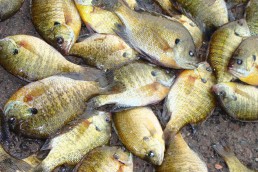Ice Fishing River Backwaters
SHARE THIS POST
When it comes to fishing quiet backwater areas, Tom Berg finds those waters can be dynamite.
Since rivers have varying degrees of current and moving water, winter fishermen must be careful to avoid unsafe ice and areas where swift currents can undermine and melt the ice from below. Never venture out onto thin ice and never fish alone. Safety should always be the number one priority.
Kankakee River backwaters
That said, the backwaters, sloughs and bayous of the Kankakee River are a favorite spot for many Illinois and Indiana ice anglers, and as soon as the ice is safe, there will be plenty of people drilling holes all over it! Note that we said the backwaters—not the main river. The shallow, brushy, often narrow areas that are out of the river’s main current are the best places to be during the early-ice period.
One of the more popular spots on the Indiana side of the Kankakee is at LaSalle Fish & Wildlife Area (FWA) near Schneider and Sumava Resorts. The LaSalle area is characterized by numerous small bayous and out-of-the-way backwaters that are filled with waterlogged timber, submerged tree branches and shorelines that are choked with flooded brush.
Past DNR creel surveys showed good catches of black crappies here (up to 13 inches), but chunky, hand-sized bluegills are often the main target of fishermen during first-ice in this area. Large numbers of bluegills can be iced in a short amount of time when they go on a feeding binge just before dark. Some can top the 9-inch mark.
The dark, mucky bottom in these bayous is home to a wide range of insects and other aquatic critters, and the panfish often cruise slowly through these areas while hunting for a meal. Drilling your holes out away from the shoreline brush can be a good plan. Sometimes, though, the fish move into the woody cover and feed right there. That’s when it pays to drill some holes next to the wood and brush and get your baits down among the submerged branches.
Since the water is typically very shallow in these backwater sloughs, it is important to be quiet to avoid spooking the fish. Many anglers drill several holes in different locations before they even start fishing, so that later they can quietly walk from one spot to another without making any noise or drilling more holes.
Are you enjoying this post?
You can be among the first to get the latest info on where to go, what to use and how to use it!
Backwater baits and big fish
Ice anglers who frequent the river backwaters use many of the same baits that other ice fishermen use on larger inland lakes. Ice spoons, ice jigs, bee moths, mousies, spikes and minnows are all favorite baits. Some anglers even prefer to use nearly weightless ice flies that sink slowly when tipped with a fat bee moth.
Besides the panfish, backwater fishermen also like to target some of the bigger gamefish that are available in the river. Largemouth and smallmouth bass are present, as are trophy-sized northern pike. Nice-sized walleyes are a good possibility, too. In fact, the both the Illinois and Indiana state record walleyes were taken from the Kanakakee River.
Bruiser pike are also a staple for backwater river anglers. Quite a few northerns are taken with large minnows or golden roaches set beneath a tip-up. Serious pike fishermen fish in groups and set multiple tip-ups.
One more note of caution: When ice fishing in any area with moving water, it is important to be very careful. Avoid areas with any appreciable current flow. Those spots can be extremely dangerous, since the moving water can melt away the ice from underneath, making it thin and unstable without any visible signs from above. Never fish alone, and make sure your fishing partners remain vigilant for thin ice, too. It’s also a good idea to carry a spiked walking stick and a coiled length of rope, just in case you or someone else falls through the ice.
Even seasoned anglers can find some great new suggestions and techniques in the pages of MidWest Outdoors, available by subscribing on our website.
MWO
SHARE THIS POST
You may also like...
Nothing found.
Did you enjoy this post?
You can be among the first to get the latest info on where to go, what to use and how to use it!
Tom Berg
A lifelong outdoorsman and award-winning outdoor writer and nature photographer, Tom Berg has been the Executive Director/Treasurer of the Hoosier Outdoor Writers group for the past 14 years. When he is not writing, he would rather be outside fishing, hunting or trapping than doing just about anything else.
